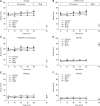Effects of Intraduodenal Infusion of the Bitter Tastant, Quinine, on Antropyloroduodenal Motility, Plasma Cholecystokinin, and Energy Intake in Healthy Men
- PMID: 31177650
- PMCID: PMC6657929
- DOI: 10.5056/jnm19036
Effects of Intraduodenal Infusion of the Bitter Tastant, Quinine, on Antropyloroduodenal Motility, Plasma Cholecystokinin, and Energy Intake in Healthy Men
Abstract
Background/aims: Nutrient-induced gut hormone release (eg, cholecystokinin [CCK]) and the modulation of gut motility (particularly pyloric stimulation) contribute to the regulation of acute energy intake. Non-caloric bitter compounds, including quinine, have recently been shown in cell-line and animal studies to stimulate the release of gastrointestinal hormones by activating bitter taste receptors expressed throughout the gastrointestinal tract, and thus, may potentially suppress energy intake without providing additional calories. This study aims to evaluate the effects of intraduodenally administered quinine on antropyloroduodenal pressures, plasma CCK and energy intake.
Methods: Fourteen healthy, lean men (25 ± 5 years; BMI: 22.5 ± 2.0 kg/m2) received on 4 separate occasions, in randomized, double-blind fashion, 60-minute intraduodenal infusions of quinine hydrochloride at doses totaling 37.5 mg ("Q37.5"), 75 mg ("Q75") or 225 mg ("Q225"), or control (all 300 mOsmol). Antropyloroduodenal pressures (high-resolution manometry), plasma CCK (radioimmunoassay), and appetite perceptions/gastrointestinal symptoms (visual analog questionnaires) were measured. Ad libitum energy intake (buffet-meal) was quantified immediately post-infusion. Oral quinine taste-thresholds were assessed on a separate occasion using 3-alternative forced-choice procedure.
Results: All participants detected quinine orally (detection-threshold: 0.19 ± 0.07 mmol/L). Intraduodenal quinine did not affect antral, pyloric or duodenal pressures, plasma CCK (pmol/L [peak]; control: 3.6 ± 0.4, Q37.5: 3.6 ± 0.4, Q75: 3.7 ± 0.3, Q225: 3.9 ± 0.4), appetite perceptions, gastrointestinal symptoms or energy intake (kcal; control: 1088 ± 90, Q37.5: 1057 ± 69, Q75: 1029 ±7 0, Q225: 1077 ± 88).
Conclusions: Quinine, administered intraduodenally over 60 minutes, even at moderately high doses, but low infusion rates, does not modulate appetite-related gastrointestinal functions or energy intake.
Keywords: Cholecystokinin; Energy intake; Gastrointestinal hormones; Pylorus; Quinine.
Conflict of interest statement
Figures



Similar articles
-
Effects of intraduodenal or intragastric administration of a bitter hop extract (Humulus lupulus L.), on upper gut motility, gut hormone secretion and energy intake in healthy-weight men.Appetite. 2023 May 1;184:106490. doi: 10.1016/j.appet.2023.106490. Epub 2023 Feb 11. Appetite. 2023. PMID: 36781111 Clinical Trial.
-
Intraduodenal Administration of L-Valine Has No Effect on Antropyloroduodenal Pressures, Plasma Cholecystokinin Concentrations or Energy Intake in Healthy, Lean Men.Nutrients. 2019 Jan 5;11(1):99. doi: 10.3390/nu11010099. Nutrients. 2019. PMID: 30621276 Free PMC article. Clinical Trial.
-
Effects of intraduodenal fatty acids on appetite, antropyloroduodenal motility, and plasma CCK and GLP-1 in humans vary with their chain length.Am J Physiol Regul Integr Comp Physiol. 2004 Sep;287(3):R524-33. doi: 10.1152/ajpregu.00039.2004. Epub 2004 May 27. Am J Physiol Regul Integr Comp Physiol. 2004. PMID: 15166004 Clinical Trial.
-
The effect of gastrointestinal bitter sensing on appetite regulation and energy intake: A systematic review.Appetite. 2023 Jan 1;180:106336. doi: 10.1016/j.appet.2022.106336. Epub 2022 Oct 8. Appetite. 2023. PMID: 36216215
-
Upper gastrointestinal sensitivity to meal-related signals in adult humans - relevance to appetite regulation and gut symptoms in health, obesity and functional dyspepsia.Physiol Behav. 2016 Aug 1;162:69-82. doi: 10.1016/j.physbeh.2016.03.021. Epub 2016 Mar 21. Physiol Behav. 2016. PMID: 27013098 Review.
Cited by
-
Review on the Regional Effects of Gastrointestinal Luminal Stimulation on Appetite and Energy Intake: (Pre)clinical Observations.Nutrients. 2021 May 11;13(5):1601. doi: 10.3390/nu13051601. Nutrients. 2021. PMID: 34064724 Free PMC article. Review.
-
Treatment of Gastrointestinal Disorders-Plants and Potential Mechanisms of Action of Their Constituents.Molecules. 2022 Apr 30;27(9):2881. doi: 10.3390/molecules27092881. Molecules. 2022. PMID: 35566230 Free PMC article. Review.
-
The Acute Effect of Hydroxychloroquine Sulfate on Hunger, the Plasma Concentration of Orexigenic Peptides and Hedonic Food Intake: A Pilot Study.Nutrients. 2023 Oct 5;15(19):4264. doi: 10.3390/nu15194264. Nutrients. 2023. PMID: 37836548 Free PMC article. Clinical Trial.
-
Bitter taste receptors as sensors of gut luminal contents.Nat Rev Gastroenterol Hepatol. 2025 Jan;22(1):39-53. doi: 10.1038/s41575-024-01005-z. Epub 2024 Oct 28. Nat Rev Gastroenterol Hepatol. 2025. PMID: 39468215 Review.
-
Effects of gastrointestinal delivery of non-caloric tastants on energy intake: a systematic review and meta-analysis.Eur J Nutr. 2021 Sep;60(6):2923-2947. doi: 10.1007/s00394-021-02485-4. Epub 2021 Feb 8. Eur J Nutr. 2021. PMID: 33559026 Free PMC article.
References
LinkOut - more resources
Full Text Sources

